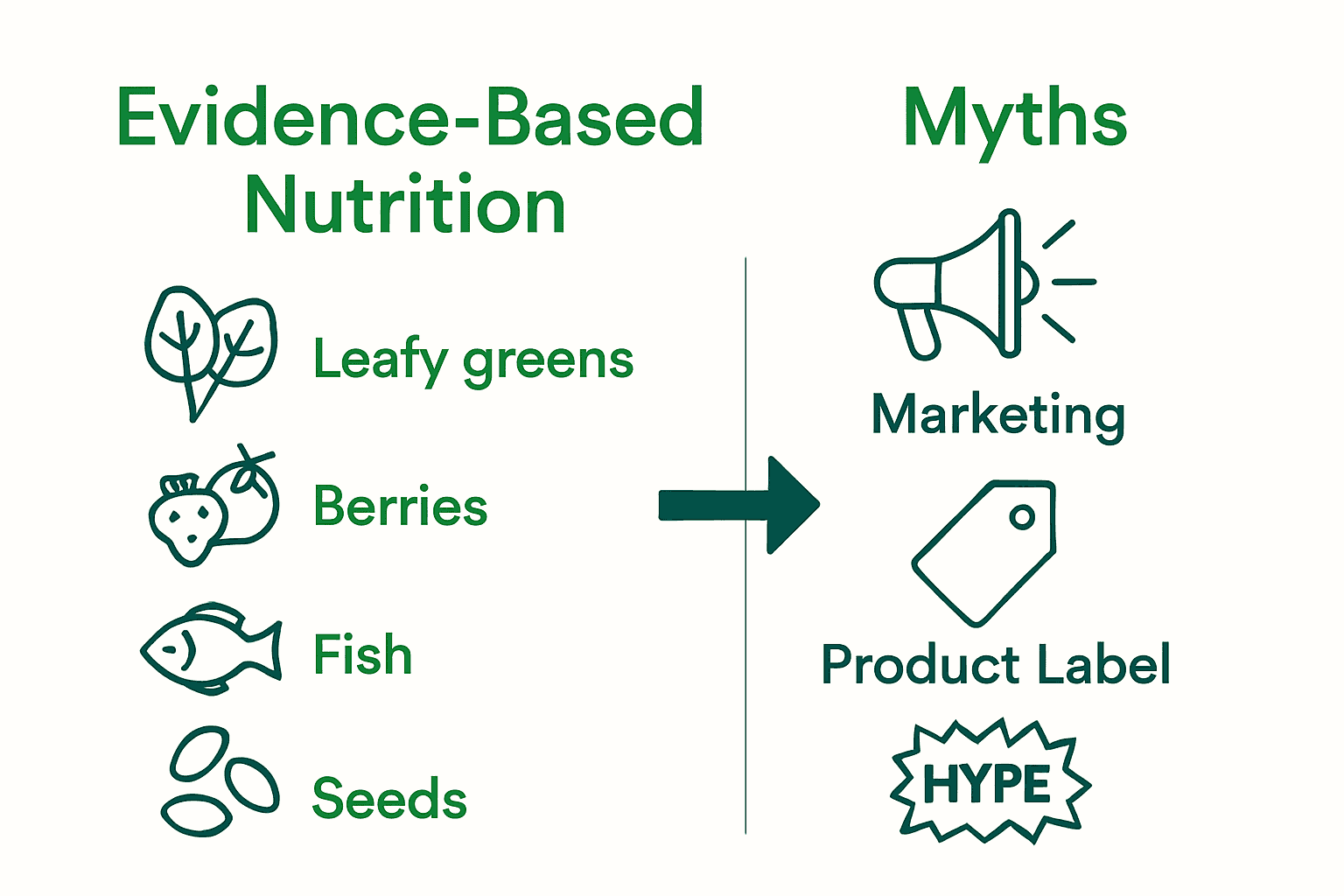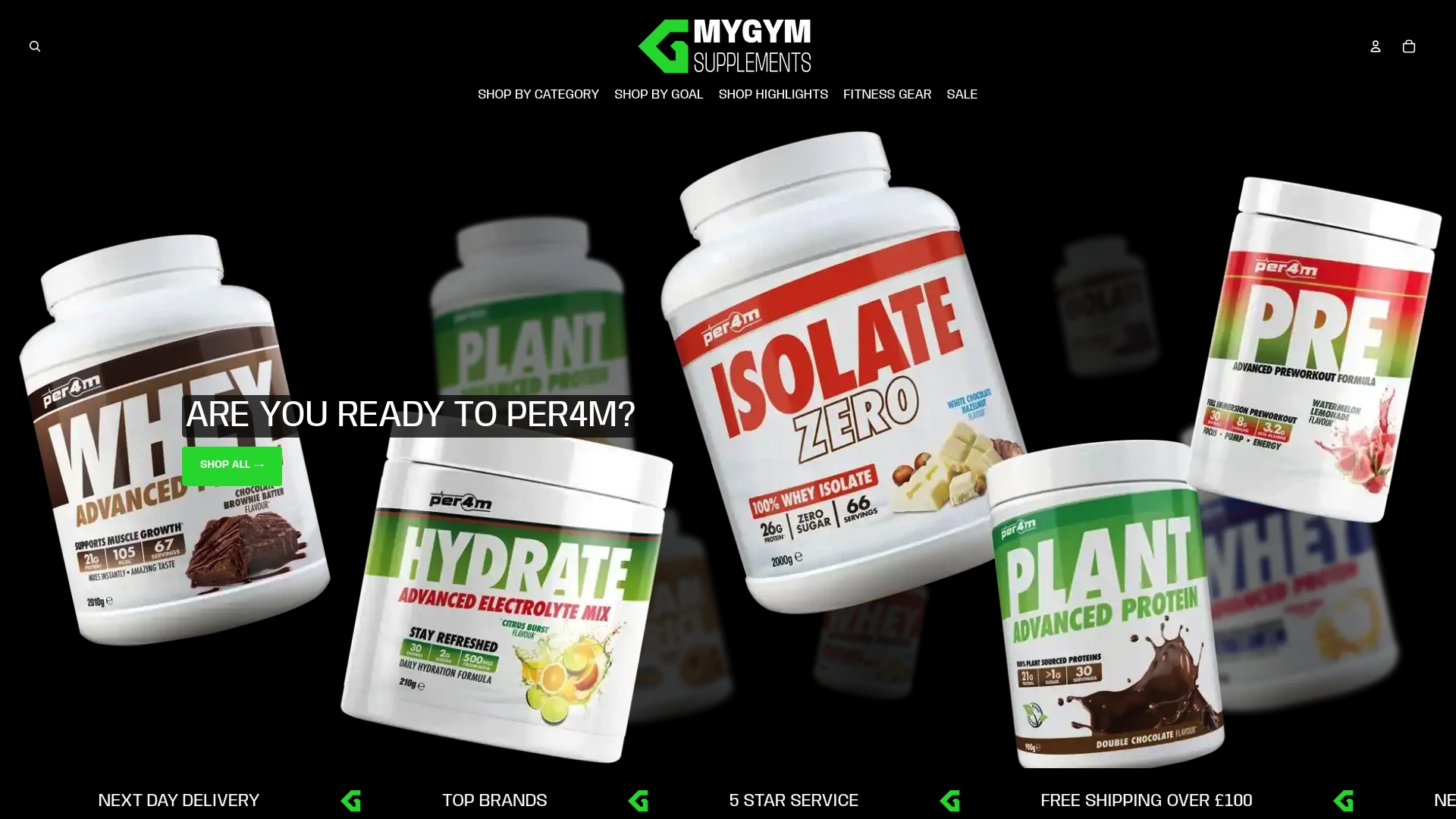The label superfood appears on countless grocery items and health blogs, but confusion surrounds what truly earns this title. More than half of UK adults believe superfoods can single-handedly solve health problems, yet science shows the story is far less magical. Understanding which foods deserve this spotlight—and why misconceptions linger—gives you a smarter way to approach nutrition and achieve real results in your fitness journey.
Table of Contents
- Defining Superfoods And Common Misconceptions
- Key Nutritional Properties Of Superfoods
- Popular Types Of Superfoods In The UK
- Evaluating Health Claims And Scientific Evidence
- Integrating Superfoods Into Your Fitness Diet
- Risks, Limitations, And Safe Consumption Guidelines
Key Takeaways
| Point | Details |
|---|---|
| Understanding Superfoods | Superfoods are nutrient-dense whole foods that support health when part of a balanced diet, not instant solutions for wellness. |
| Nutritional Properties | Superfoods provide concentrated micronutrients, antioxidants, and compounds beneficial for health, aiding recovery and metabolic function. |
| Integration Strategies | Effective superfood use requires strategic incorporation into meals, considering timing, balance, and variety to optimize fitness results. |
| Consumer Caution | Evaluate health claims critically; superfoods should be chosen based on scientific evidence, not marketing hype, to avoid misconceptions. |
Defining Superfoods and Common Misconceptions
The term superfood gets thrown around fitness and nutrition circles like confetti at a celebration. But what does it really mean? According to research from the University of Reading, superfoods are not magical miracle ingredients, but nutrient-dense foods with potentially beneficial health properties.
Many people misunderstand superfoods as instant health solutions. The reality is more nuanced. Superfoods are essentially whole foods packed with higher concentrations of essential nutrients, antioxidants, and bioactive compounds. They aren’t pharmaceutical treatments but natural dietary components that can support overall wellness when incorporated into a balanced diet. Key characteristics typically include:
- High nutrient density
- Concentrated micronutrient profile
- Presence of unique bioactive compounds
- Potential anti-inflammatory properties
Common misconceptions plague the superfood landscape. Some individuals believe consuming superfoods guarantees immediate health transformations. This oversimplified view ignores the complex interactions between nutrition, lifestyle, and individual metabolic processes. University of Reading research emphasises that while certain foods offer exceptional nutritional profiles, they work best as part of a comprehensive dietary strategy, not as standalone miracle solutions.
Understanding superfoods requires moving beyond marketing hype and examining their genuine nutritional contributions. They represent concentrated nutritional sources that can complement a well-rounded diet, but they aren’t replacement for balanced nutrition. For fitness enthusiasts and athletes, integrating these nutrient-rich foods strategically can support performance, recovery, and overall health - provided expectations remain realistic and scientifically grounded.
Key Nutritional Properties of Superfoods
Navigating the nutritional landscape of superfoods requires understanding their micronutrient complexity. According to UK Government’s Nutrient Analysis, these foods are characterized by exceptionally dense nutritional profiles that go far beyond basic caloric content. The data reveals that true superfoods aren’t just about high vitamin counts, but about the intricate balance and bioavailability of nutrients.
The nutritional composition of superfoods typically encompasses a robust spectrum of essential elements. McCance and Widdowson’s Composition of Foods Integrated Dataset highlights several key nutritional properties that distinguish these foods:
- High concentration of micronutrients per gram
- Significant antioxidant levels
- Diverse mineral and vitamin profiles
- Enhanced protein and amino acid content
- Low caloric density relative to nutritional value
Protein quality and amino acid composition represent critical differentiators among superfoods. While traditional foods might provide basic nutritional requirements, superfoods offer more concentrated and readily absorbable nutrient packages. For athletes and fitness enthusiasts, this means potentially superior recovery, enhanced metabolic function, and more efficient cellular repair mechanisms.
Understanding micronutrient absorption is as crucial as identifying nutrient content. Some superfoods contain compounds that actually enhance nutrient uptake, making them more than just ingredient lists. When strategically incorporated into a balanced diet, these nutritional powerhouses can support performance, recovery, and overall physiological optimization.
Popular Types of Superfoods in the UK
Green vegetables and plant-based foods dominate the UK’s superfood landscape, offering remarkable health benefits. University of Warwick research highlights specific foods like broccoli and onions as nutritional powerhouses, revealing their potential to enhance cellular defense mechanisms and reduce risks of chronic diseases.
The most prominent superfoods in the UK encompass a diverse range of nutrient-dense options:
- Leafy Greens: Kale, spinach, and Swiss chard
- Cruciferous Vegetables: Broccoli, cauliflower, Brussels sprouts
- Berries: Blueberries, strawberries, blackberries
- Fatty Fish: Salmon, mackerel, sardines
- Nuts and Seeds: Almonds, chia seeds, flaxseeds
- Whole Grains: Quinoa, oats, brown rice
King’s College London emphasises that these superfoods are particularly beneficial when integrated into a balanced diet rich in fruits, vegetables, and lean proteins. Their research suggests that such dietary patterns can potentially mitigate health conditions and support overall wellness.
Here’s a structured comparison of popular superfoods in the UK and their key nutritional benefits:
| Superfood Type | Main Examples | Key Nutritional Properties |
|---|---|---|
| Leafy Greens | Kale Spinach Swiss chard |
High in vitamins A, C, K Folate Iron |
| Cruciferous Vegetables | Broccoli Cauliflower Brussels sprouts |
Antioxidants Fibre Vitamin C Glucosinolates |
| Berries | Blueberries Strawberries Blackberries |
Polyphenols Vitamin C Fibre |
| Fatty Fish | Salmon Mackerel Sardines |
Omega-3 fatty acids Vitamin D Protein |
| Nuts and Seeds | Almonds Chia seeds Flaxseeds |
Healthy fats Magnesium Plant protein |
| Whole Grains | Quinoa Oats Brown rice |
Complex carbs Fibre B vitamins |
For fitness enthusiasts seeking to incorporate these nutritional powerhouses, understanding their unique properties is crucial. Consider exploring green powder supplements as a convenient method to boost nutrient intake, especially for those with challenging dietary schedules. Remember, while superfoods offer exceptional nutritional profiles, they work best as part of a comprehensive, varied diet tailored to individual health goals.
Evaluating Health Claims and Scientific Evidence
Scientific scrutiny is the critical lens through which superfood claims must be examined. University of Leicester’s review highlights the importance of distinguishing between marketing hype and genuine nutritional evidence, cautioning consumers against accepting superfood claims at face value.
When evaluating health claims, fitness enthusiasts and health-conscious individuals should consider several key scientific criteria:
- Presence of peer-reviewed research
- Statistically significant sample sizes
- Reproducible experimental results
- Transparent methodology
- Independent verification of claims
- Long-term health impact studies
Open University research reveals that consumer perceptions of superfoods are often driven by psychological factors rather than solid scientific evidence. This means many individuals choose superfoods based on perceived benefits and marketing narratives instead of concrete nutritional research. The concept of “relative advantage” plays a significant role in how people select and consume these supposedly miraculous foods.
To make informed nutritional choices, it’s crucial to learn how to read supplement labels critically. Not all health claims are created equal, and understanding the nuanced difference between marketing rhetoric and scientific substantiation can protect consumers from investing in products with inflated promises. Remember: a true superfood should offer measurable, evidence-based health benefits, not just impressive-sounding claims.

Integrating Superfoods Into Your Fitness Diet
Strategic nutrition transforms fitness performance, and incorporating superfoods requires more than random selection. King’s College London research emphasises replacing ultra-processed foods with nutrient-dense alternatives to optimize health and athletic potential.
Successful superfood integration involves multiple strategic approaches:
- Meal Preparation Techniques
- Strategic Timing of Consumption
- Balanced Macro and Micronutrient Planning
- Portion Control
- Variety and Rotation
- Complementary Food Combinations
Practical implementation means thinking beyond simple ingredient addition. Athletes and fitness enthusiasts should view superfoods as precision nutrition tools, carefully selected to support specific performance and recovery goals. This might mean incorporating protein-rich quinoa post-workout, adding antioxidant-packed berries to morning smoothies, or using omega-rich chia seeds as strategic energy boosters.
For those seeking convenient nutritional optimization, exploring greens powders offers an efficient method to rapidly incorporate multiple superfood benefits.
 Remember: integration is about consistency, quality, and understanding how specific nutrients support your unique fitness journey.
Remember: integration is about consistency, quality, and understanding how specific nutrients support your unique fitness journey.
Risks, Limitations, and Safe Consumption Guidelines
Superfood consumption requires a nuanced understanding beyond marketing promises. University of Reading’s research summary critically highlights that while superfoods offer potential health benefits, they are not miracle solutions and come with specific risks and limitations that consumers must carefully navigate.
Key risks and potential limitations include:
- Potential interactions with medications
- Risk of nutrient overdose
- Allergic reaction potential
- Varying individual metabolic responses
- Quality and sourcing inconsistencies
- Possible contamination from unregulated sources
- Excessive financial investment without proportional returns
Consumers must approach superfood integration with scientific skepticism and personal health awareness. This means understanding that individual responses to superfoods can vary dramatically based on genetic makeup, existing health conditions, and overall dietary context. Some individuals might experience significant benefits, while others might see minimal or even adverse reactions.
To ensure safe and effective superfood consumption, follow these critical guidelines: consult healthcare professionals before major dietary changes, purchase from reputable sources, understand personal health limitations, maintain dietary diversity, and learn to read supplement labels with a critical eye. Remember, superfoods are nutritional tools, not universal panaceas.
Unlock the True Power of Superfoods with Smart Supplement Choices
Understanding superfoods means recognising they are potent nutritional tools rather than miracle cures. If your goal is to enhance fitness, support recovery or boost overall wellbeing, relying solely on diet may not always meet your body’s full needs. This is especially true when you want consistent, balanced micronutrient intake and effective support for muscle gain or energy optimisation.

Discover how combining nutrient-dense whole foods with carefully selected supplements can take your performance and health to the next level. At MyGymSupplements.shop, you have access to a wide range of products designed to complement your superfood-rich diet. Whether you need proteins for muscle repair, vitamins and minerals to fill nutritional gaps, or specialised recovery aids, our store is tailored to fit your fitness goals. Visit now to explore smart, science-backed choices that empower your nutrition strategy for lasting results.
Frequently Asked Questions
What are superfoods and what are their main characteristics?
Superfoods are nutrient-dense foods that provide potentially beneficial health properties. Key characteristics include high nutrient density, a concentrated micronutrient profile, unique bioactive compounds, and potential anti-inflammatory effects.
Do superfoods guarantee immediate health benefits?
No, consuming superfoods does not guarantee immediate health transformations. They are part of a broader balanced diet and their benefits are maximized when integrated into an overall healthy lifestyle.
How can I incorporate superfoods into my diet effectively?
To effectively incorporate superfoods, consider meal preparation techniques, strategic timing of consumption, balanced macro and micronutrient planning, portion control, and variety in your food choices to meet your specific health and fitness goals.
Are there any risks associated with consuming superfoods?
Yes, potential risks include interactions with medications, nutrient overdose, allergic reactions, and individual metabolic responses. It’s important to consult healthcare professionals before major dietary changes and to maintain a diverse diet.
Recommended
- What are Greens Powders? Understanding Nutritional Benefits – MyGymSupplements
- What Is Green Powder? Complete Nutritional Overview – MyGymSupplements
- Benefits of Plant Protein: Complete Guide for Fitness – MyGymSupplements
- Protein Supplements: Everything You Need to Know – MyGymSupplements
- Nutrition for Brain Health: Complete Essential Guide – Omnia Radiation Balancer



0 comments